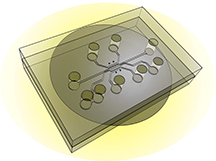
This illustration shows the design of a new chip capable of simulating a tumor’s “microenvironment” to test the effectiveness of nanoparticles and drugs that target cancer. The new system, called a tumor-microenvironment-on-chip device, will allow researchers to study the complex environment surrounding tumors and the barriers that prevent the targeted delivery of therapeutic agents. (Credit:-Purdue University photo/Altug Ozcelikkale, Bumsoo Han)
Researchers have developed a chip capable of simulating a tumor’s “microenvironment” and plan to use the new system to test the effectiveness of nanoparticles and drugs that target cancer.
The new system, called a tumor-microenvironment-on-chip (T-MOC) device, will allow researchers to study the complex environment surrounding tumors and the barriers that prevent the targeted delivery of therapeutic agents, said Bumsoo Han, a Purdue University associate professor of mechanical engineering.
Researchers are trying to perfect “targeted delivery” methods using various agents, including an assortment of tiny nanometer-size structures, to selectively attack tumor tissue.
One approach is to design nanoparticles small enough to pass through pores in blood vessels surrounding tumors but too large to pass though the pores of vessels in healthy tissue. The endothelial cells that make up healthy blood vessels are well organized and have small pores in the tight junctions between them. However, the endothelial cells in blood vessels around tumors are irregular and misshapen, with larger pores in the gaps between the cells.
“It was thought that if nanoparticles were designed to be the right size they could selectively move toward only the tumor,” Han said.
However, one complication hindering the success of this strategy is that the pressure of “interstitial fluid” inside tumors is greater than that of surrounding healthy tissue. This greater pressure pushes out most drug-delivery and imaging agents, with only a small percentage of them reaching the target tumor.
Now, new research findings suggest that the T-MOC system is capable of simulating the complex environment around tumors and providing detailed information about how nanoparticles move through this environment. Such information could aid efforts to perfect targeted delivery methods.
The findings are detailed in a research paper appearing online this month and will be published in a print edition of the Journal of Controlled Release in November. The paper was authored by postdoctoral research associate Bongseop Kwak; graduate students Altug Ozcelikkale and Crystal S. Shin; Kinam Park, the Showalter Distinguished Professor of Biomedical Engineering and a professor of pharmaceutics; and Han.
The T-MOC chip is about 4.5 centimeters (1.8 inches) square and contains “microfluidic” channels where tumor cells and endothelial cells are cultured. The chip also incorporates extracellular matrix – a spongy, scaffold-like material made of collagen found between cells in living tissue.
The new chip offers an alternative to conventional experimental methods. Studies using cancer cells in petri plates exclude the complex microenvironment surrounding tumors, and research with animals does not show precisely how proposed therapies might work in people.
However, the T-MOC system has the potential to mimic cancer in humans, Han said.
The researchers tested the technology using human breast cancer and endothelial cells and studied how nanoparticles moved within the microenvironment.
Future work will expand to the study of anticancer drugs. Eventually, the devices might be used to grow tumor cells from patients to gauge the effectiveness of specific drugs in those people.
Source: Purdue University.
Published on 29th September 2014
|
|


